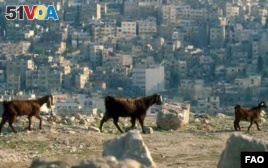December 16,2013
About 70 percent of the new diseases that have infected humans in recent decades have come from animals. The U.N. Food and Agriculture Organization warns it’s getting easier for diseases to make that jump as the population and food-supply chains grow.

FAO says expanding agriculture is encroaching on wildlife habitat and increasing risk of animal to human disease threat. FAO / Spaul
The FAO has released a new reported called World Livestock 2013: Changing Disease Landscapes. It says those landscapes have become “vastly more complicated” by human activity.
“I think that if we continue the state of play, we’ll only see more diseases emerge – more natural resources disappear – and more threats to the human health into the food chain,” said Juan Lubroth, the agency’s Chief Veterinary Officer.
He described conditions as the “perfect microbial storm.”
“We have certain issues such as climate change, particularly humidity and tropical weathers. We have increased globalization, more traffic across the world. People traveling more, more trade. We are encroaching into habitats that previously we as humans did not really know those ecological niches were occupied by other species. But we are invading them.”
He said inadequate healthcare systems and sanitation infrastructure raise the risk of disease in poor areas. And as population grows, livestock production intensifies, which has its own set of risk factors.
“As we intensify livestock production, we have created, let’s say, a monoculture. By using antibiotics, for example, as growth promoters or antibiotics without the supervision of qualified personnel, we do allow for disease resistant organisms to go throughout the herd or throughout the community. And this can, at the end, affect human health,” he said.
Lubroth gave some examples of diseases that have jumped from animals to humans.
“The origin of the human immunodeficiency virus, HIV, which causes AIDS, probably had its precursor in something that we know today to be simian or monkey immunodeficiency virus. And then even more recently, we have the Middle East Respiratory Syndrome, which is caused by a corona virus, which likely has an animal origin. We are at the point in research, which we still are trying to find out what origin that is.”
Other diseases that have emerged from animals over the last five to ten years, he says, include the Nipah and Hendra viruses. These are usually found in bats.
“Probably more familiar to your readers or listeners will be the H5N1avian influenza, which in 2003 spread in Southeast Asia. And by 2006 was present in over 60 countries and territories,” he said.
The Food and Agriculture Organization is calling for a holistic approach to meet the growing disease threat. This involves scientists, researchers and doctors and others from many disciplines working together and sharing information.
The report said the holistic approach includes reducing poverty, addressing biological threats posed by globalization and climate change and better safety and health measures in livestock production.
The FAO Chief Veterinary Officer is promoting – what he called – tackling the disease at source. He said that means snuffing out a potential outbreak at a particular location, village or town before it can spread.